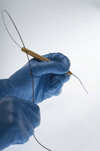Use of lasers in laryngeal surgery
- PMID: 19487102
- PMCID: PMC3325096
- DOI: 10.1016/j.jvoice.2008.09.006
Use of lasers in laryngeal surgery
Abstract
Lasers are a relatively recent addition to laryngeal surgery. Since their invention, laser use and applications have expanded rapidly. In this article, we discuss the benefits and disadvantages of lasers for different procedures, as well as ways to overcome commonly faced clinical problems. The use of lasers in surgery has offered a time- and cost-efficient alternative to cold surgical techniques, and has been used in the treatment of numerous laryngeal pathologies, including stenoses, recurrent respiratory papillomatosis, leukoplakia, nodules, malignant laryngeal disease, and polypoid degeneration (Reinke's edema). However, lasers can incur adjacent tissue damage and vocal fold scarring. These problems can be minimized through understanding the mechanisms by which lasers function and correctly manipulating the parameters under a surgeon's control. By varying fluence, power density, and pulsation, tissue damage can be decreased and lasers can be used with greater confidence. The various types of lasers and their applications to the treatment of specific pathologies are reviewed with the intention of helping surgeons select the best tool for a given procedure. Recent applications of lasers to treat benign laryngeal lesions and severe laryngomalacia demonstrate that additional research must be conducted to realize the full potential of this surgical tool.
Copyright 2010 Elsevier Ltd. All rights reserved.
Figures







Similar articles
-
Laryngeal surgery using a CO2 laser: is a polyvinylchloride endotracheal tube safe?Am J Otolaryngol. 2012 Nov-Dec;33(6):714-7. doi: 10.1016/j.amjoto.2012.06.005. Epub 2012 Aug 9. Am J Otolaryngol. 2012. PMID: 22884483
-
Laser surgery for nodules and other benign laryngeal lesions.Curr Opin Otolaryngol Head Neck Surg. 2009 Dec;17(6):440-4. doi: 10.1097/MOO.0b013e3283317cae. Curr Opin Otolaryngol Head Neck Surg. 2009. PMID: 19726988 Review.
-
Feasibility and Associated Limitations of Office-Based Laryngeal Surgery Using Carbon Dioxide Lasers.JAMA Otolaryngol Head Neck Surg. 2017 May 1;143(5):485-491. doi: 10.1001/jamaoto.2016.4129. JAMA Otolaryngol Head Neck Surg. 2017. PMID: 28208177 Free PMC article.
-
Office-Based 532-Nanometer Pulsed Potassium-Titanyl-Phosphate Laser Procedures in Laryngology.Otolaryngol Clin North Am. 2019 Jun;52(3):537-557. doi: 10.1016/j.otc.2019.02.011. Epub 2019 Mar 26. Otolaryngol Clin North Am. 2019. PMID: 30922560 Review.
-
In-office laryngeal surgery with the 585-nm pulsed dye laser.Curr Opin Otolaryngol Head Neck Surg. 2007 Dec;15(6):387-93. doi: 10.1097/MOO.0b013e3282f19ef2. Curr Opin Otolaryngol Head Neck Surg. 2007. PMID: 17986876 Review.
Cited by
-
Diode Laser for Laryngeal Surgery: a Systematic Review.Int Arch Otorhinolaryngol. 2016 Apr;20(2):172-9. doi: 10.1055/s-0036-1579741. Epub 2016 Mar 4. Int Arch Otorhinolaryngol. 2016. PMID: 27096024 Free PMC article. Review.
-
Indications, Efficacy, Safety, and Clinical Outcomes of 585 nm Pulsed Dye Laser in Non-Malignant Laryngeal Lesions: A Systematic Review.J Pers Med. 2023 Sep 14;13(9):1374. doi: 10.3390/jpm13091374. J Pers Med. 2023. PMID: 37763142 Free PMC article. Review.
-
Risk of airway fire with the use of KTP laser and high flow humidified oxygen delivery in a laryngeal surgery model.Sci Rep. 2022 Jan 11;12(1):543. doi: 10.1038/s41598-021-04636-3. Sci Rep. 2022. PMID: 35017619 Free PMC article.
-
Optimizing Settings for Office-Based Endoscopic CO2 Laser Surgery Using an Experimental Vocal Cord Model.Laryngoscope. 2020 Nov;130(11):E680-E685. doi: 10.1002/lary.28518. Epub 2020 Feb 5. Laryngoscope. 2020. PMID: 32022931 Free PMC article.
-
Recurrent respiratory papillomatosis by HPV: review of the literature and update on the use of cidofovir.Acta Otorhinolaryngol Ital. 2014 Dec;34(6):375-81. Acta Otorhinolaryngol Ital. 2014. PMID: 25762828 Free PMC article. Review.
References
-
- Maiman TH. Stimulated optical radiation in ruby. Nature. 1960;187:493.
-
- Ossoff RH, Coleman JA, Courey MS, Duncavage JA, Werkhaven JA, Reinisch L. Clinical applications of lasers in otolaryngology--head and neck surgery. Lasers Surg Med. 1994;15(3):217–248. Review. - PubMed
-
- Duncavage JA, Ossoff RH. Laser application in the tracheobronchial tree. Otolaryngol Clin North Am. 1990 Feb;23(1):67–75. Review. - PubMed
-
- Ossoff RH, Matar SA. The advantages of laser treatment of tumors of the larynx. Oncology (Williston Park) 1988 Sep;2(9):58–61. 64–65. - PubMed
-
- Jako GJ. Laser surgery of the vocal cords. An experimental study with carbon dioxide lasers on dogs. Laryngoscope. 1972 Dec;82(12):2204–2216. - PubMed
Publication types
MeSH terms
Grants and funding
LinkOut - more resources
Full Text Sources
Other Literature Sources

